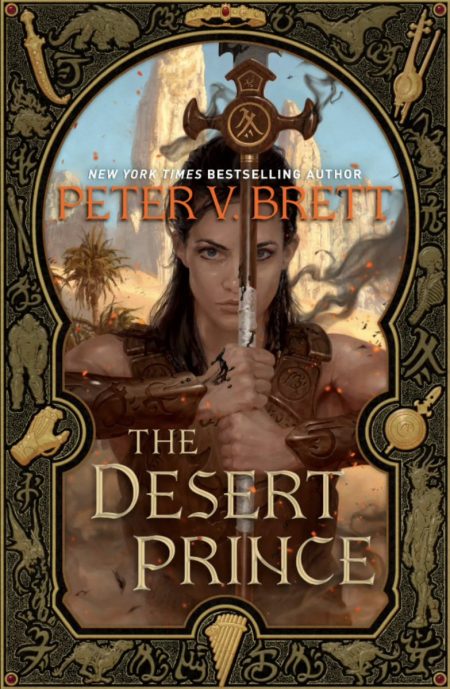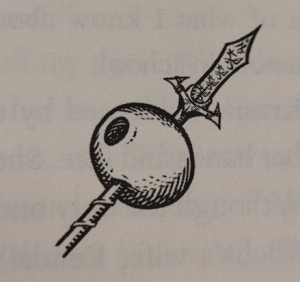
BOOK INFORMATION
Genres: Fantasy Fiction, Epic Fantasy
First Released: 2021
Part of a Series: Yes; Book 1 in The Nightfall Saga
Call Number: FANTASY BRETT
Eyan’s Rating: 4.5/5
Find it: Physical copy on the 3rd Floor.
For Fans of: Jenn Lyons, Erica Johansen and Terry Brooks
SUMMARY
The Desert Prince by Peter V. Brett is an all-new story set in the world of Brett’s beloved Demon Cycle series. Fifteen years ago, humankind won a devastating war against an army of demons. They were led by a generation of heroes whose lives have become legends. Their children live in peace and in the shadow of their parents’ legacies.
Darin is the son of the greatest of these heroes, a man venerated as a near-god. The world expects Darin to be like his father, but he couldn’t feel more different; he’s a gentle musician who prefers his violin to a sword.
Olive’s parents are royals from rival kingdoms and were once powerful demon hunters. Olive has lived a sheltered life in the palace but soon discovers they’ve inherited their parents’ incredible magical power… and a love for combat.
Olive and Darin both grew up in a world their parents made possible for them: one where demons no longer torment mankind. But there are signs that the demons have returned to the earth—and that they might be hunting Olive. Now Olive and Darin have to prepare to face this ancient threat… and to fight for the freedom to create their own destinies.
EYAN’S REVIEW
I’ve been reading Brett’s work since he first published The Warded Man in 2009 (released in the UK with the title The Painted Man). That novel launched Brett’s first series, The Demon Cycle. (FYI, you don’t need to read those novels to enjoy The Desert Prince.)
Olive Paper, the heir to Hollow Duchy, has been raised far more isolated and sheltered than her childhood friend and companion, Darin Bales—though even Darin has been raised quite sheltered. Both are the children of heroes and have to contend with the pressure of that legacy juxtaposed with their unique desires. In a sense, Olive and Darin’s lack of background knowledge helps new readers because the narrators don’t have all the answers either.
One of Brett’s significant shifts in storytelling techniques in this new series is the change from a third-person omniscient narrator in The Demon Cycle to first-person narration in The Desert Prince. The original series follows a handful of characters over a span of many years. The first novel introduces the reader to these characters but only closely follows the first three: Arlen Bales, Leesha Paper and Rojer “Halfgrip” Inn. Each chapter in the series is topped with a symbol relating to the character:
![]()
Arlen Bales
![]()
Leesha Paper
![]()
Rojer “Halfgrip” Inn
However, the chapters are still told from a third-person omniscient narrator. This is a common method of fiction novel writing wherein the narrator (author) knows everything, even if the characters don’t. The narrator might include details about the thoughts or feelings of a character, but there is the sense that the narrator knows all, and the story is just unfolding in the proper order.
In the original series, when Arlen is scared or frightened, we know, and we know why. When Arlen is unaware of the forthcoming betrayal from his friend, however, we only know because the narrator knows. Arlen himself is blissfully unaware. Third-person omniscient narration removes the narrator from the story, allowing for a bird’s-eye or fly-on-the-wall view of the novel.
However, the trouble with third-person narration, for me, is the lack of intimate connection to any specific character. Yes, when I read The Demon Cycle, I bonded with a couple of characters, but I never really got to know them the same way I understand characters whose heads I’ve been inside through first-person narration. Enter The Desert Prince.
In this first novel of a new series, Brett once again gives us more than one character to follow. However, both Olive Paper and Darin Bales have separate chapters told from their unique first-person voice. This novel also uses symbols at the top of each chapter, and the artwork continues to both define and complement the characters. The book starts with Olive, so let’s start with them as well.
Olive Paper is the child of Duchess Leesha Paper of Hollow, and Ahmann Jardir, the Shar’Dama Ka of New Krasia. Olive’s symbol uses part of their father’s symbol from the original series. In The Demon Cycle, Jardir’s symbol is the Spear of Kaji, a weapon with religious significance to him and his people. Here’s what that looks like:![]()
In the first series, there is a lot of emphasis on the role of the deliverer (the “chosen one” in this series), and using Kaji’s ancient weapon carries a price Jardir must pay. By Olive’s time, however, Jardir’s spear is associated with Jardir’s glory in the war fifteen years ago. Olive, Darin and the other children of this new world think of Jardir as a myth, even though he is Olive’s father.
A large part of Olive’s character is centered around their identity as an intersex person. There’s an in-universe reason for this that was first discussed at the end of The Demon Cycle. When Olive was born, Leesha and her advisors decided to raise Olive as a girl for her protection, although Olive is frustrated by many aspects of this forced identity when we first meet them. Throughout the course of the novel, Olive has to contend with their own identity, living first as a girl, then exploring more aspects of their true identity as they gain more and more world experience.
I refer to Olive mostly with they/them pronouns because Olive moves between she/her and he/him throughout the novel and also because their own descriptions of identity specifically place them outside the binary. I hope we get more of Olive’s development in that regard as the series continues. All young people have a coming-of-age story, and Olive’s unique identity opens up the field of conversation much wider. They live in a world where women have gained more political power since their mother became a Duchess, but even that power is limited to specific “acceptable” behaviors. Likewise, what is acceptable for men in her father’s land is often as rigidly defined as any of the rules placed upon her as a young Princess.
 When Olive’s first chapter opens with this symbol, the connection between Olive’s identity and Jardir’s is emphasized. For those new to the world and the characters, that’s not a detail that will change your early understanding of Olive, but I love the clear connections between the symbols right from the start. Olive might be Jardir’s child (shown with the spear), but your eye is drawn first to the large central Olive.
When Olive’s first chapter opens with this symbol, the connection between Olive’s identity and Jardir’s is emphasized. For those new to the world and the characters, that’s not a detail that will change your early understanding of Olive, but I love the clear connections between the symbols right from the start. Olive might be Jardir’s child (shown with the spear), but your eye is drawn first to the large central Olive.
Darin Bales, meanwhile, is the opposite of Olive in many ways. He was born with some inherent magical ability because of his parents’ involvement in the Demon War, but Darin doesn’t want to be a fighter or a hero like his late father. He was raised off the grid by his mother and now must confront his father’s legacy if he is to discover his destiny. He contemplates the words of prophecy spoken over him: the father waits below. But how could this prophecy mean his father, Arlen, who sacrificed himself to save the world all those years ago?
If the second book in the series, tentatively titled The Hidden Queen, follows the format of The Demon Cycle, then the next book will continue to follow Olive and Darin while opening up the perspective to include other characters. The characters I’d love to see from a first-person account include:
- Selen Cutter: Olive’s aunt and companion. They were born only weeks apart, so they were raised together. Selen is a significant character in The Desert Prince, both as the companion to Olive and to Darin as they attempt to find their friend.
- Rojvah Inn: daughter of Amanvah (a powerful priestess and the eldest daughter of Jardir) and the late Rojer “Halfgrip” Inn. Rojvah is training to be her mother’s heir, though she wishes to take after her father instead.
- Arick Inn: son of Rojer Halfgrip and Sikvah (Jardir’s warrior niece, who perished in the Demon War). Since he is the only son of Rojer, he is meant to carry on his father’s legacy as a musician, but Arick wishes to be a warrior like his mother and grandfather.
- Kaji: son of Asome and Ashia, eldest grandchild of Jardir, the heir to the Skull Throne and Jardir’s seat of power. He might be too old as the focus of this series, as he was already a year old at the end of The Demon Cycle when the other children were just being born or conceived, but I’d love to learn about his life.
- Marya Messenger: the child of Regan and Elissa, current Duke and Duchess of Fort Miln, who had played the role of surrogate parents to Arlen Bales in the original series. Since Brett brought Regan and Elissa back in a major way at the end of the series, I wouldn’t be surprised to see them return as the new series progresses. So far, we have yet to visit Fort Miln in The Nightfall Saga, so there’s lots of opportunity ahead.
Lots of times, sequel series fall short of the original. But this series is an exception, with The Desert Prince ranking more enjoyable to me than a handful of the original novels. This is a fantastic opening to a new series, and while seasoned Brett fans will recognize characters, places and events within this new novel, a lack of knowledge only plays into the narrative. If you don’t know anything about the world, that’s ok because Olive and Darin only know what they’re told, as well.
